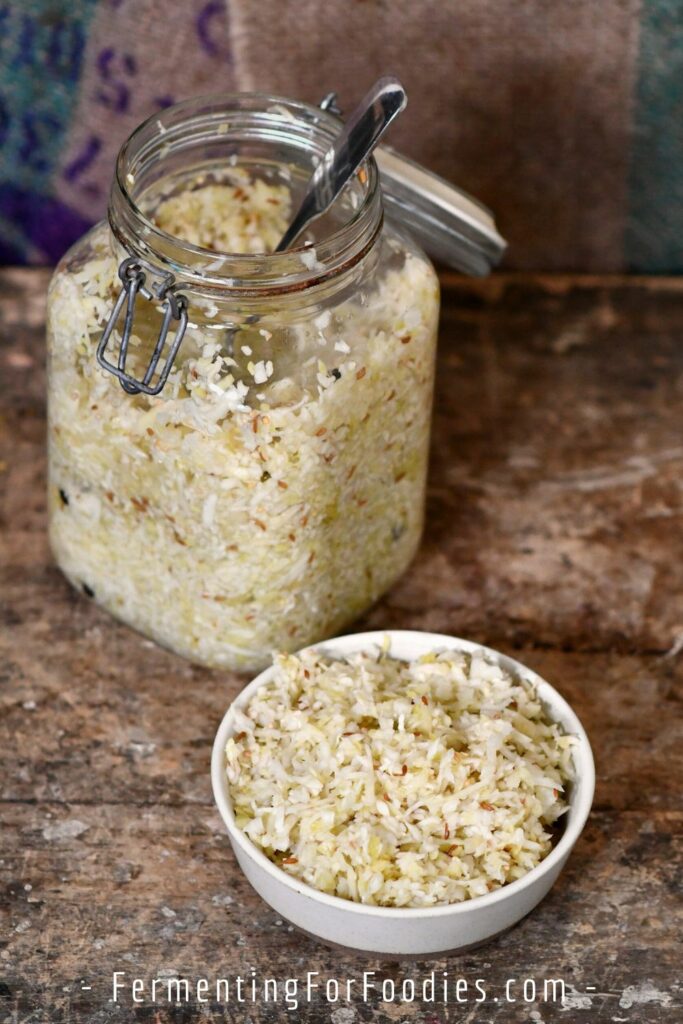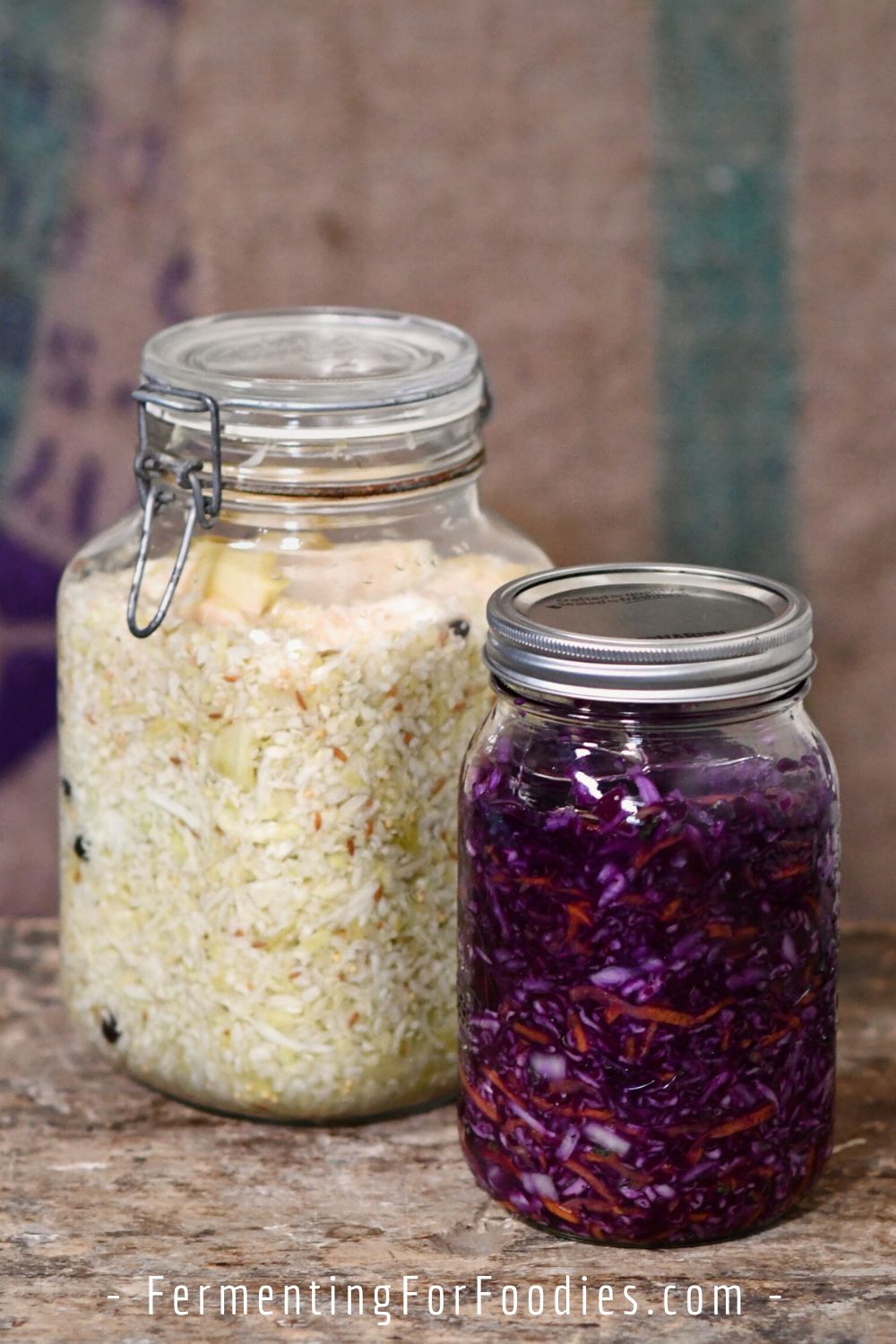Fermented sauerkraut is easy to make. It is a wonderfully reliable ferment and doesn’t take any special skills or ingredients. Perfect for beginners!

Here are a few reasons why I make at least 5 quarts of kraut every year.
- Sauerkraut is a great source of probiotics and vitamin C.
- It is packed with flavor, perfect for adding tanginess to all your meals.
- It’s simple and affordable. I stock up whenever our local cabbage cabbage is on-sale, so we can enjoy kraut all winter long.
- Fermented sauerkraut is so much BETTER than the stuff you find in a jar at your local grocery store.
Why Sauerkraut is so easy to ferment
Sauerkraut is a good ferment for beginners because cabbage naturally has lactic acid bacteria on the leaves. So it is a really reliable ferment. So all that you need to do to make sauerkraut is grate it and add a bit of salt!
I have taught preschoolers how to make sauerkraut. I have taught uninterested teens how to make sauerkraut. It is that easy.
–> You can make sauerkraut in an old pasta sauce jar. Let it ferment for 3 to 5 days for a really bubbly ferment.
–> If you want to store kraut in your pantry for 2 weeks to a year, I recommend reading this post on How to Ferment. It goes into detail about cleanliness, the ideal temperature for fermentation, and more!
Here’s a video showing how I make fermented sauerkraut.
Flavors
The best thing about making your own kraut is that you can experiment with FLAVOR!
Here are 10 flavors that we enjoy. If you have a favorite flavor that isn’t on this list, please share it in the comments section! Each of these spice mixes are designed for 1 batch of kraut (based on 1 cabbage).
- Classic Eastern European: This is my favorite spice combination, 1 tsp caraway seed, 1 tsp mustard seed, and 10 juniper berries. This gives the kraut a very traditional flavor.
- Pepper bay: Another popular spice combo is 2 bay leaves and 5 black peppercorns.
- Dill pickle: For a dill pickle flavor, add 1 tsp dill seed and 1 finely diced clove of garlic.
- Sweet: Add 1 cup of grated apple, fennel, beets, or carrots to the kraut and only let it ferment for 3 to 5 days.
- Savory: Onion and garlic are savory additions.
- Low-sodium sauerkraut: There’s a few ways to ferment kraut and make sure it’s low-sodium.
- Curry kraut: Add 1 finely chopped onion and 1 grated carrot with 2 tsp of mixed Indian curry spice.
- Hot and spicy: Add in 1 to 4 finely diced hot peppers. The amount of heat will depend on the type of pepper.
- Curtido: This South American cabbage ferment is flavored with carrot, onion and oregano.
- Turmeric sauerkraut: Pack in some antioxidants by adding fresh turmeric.

Containers for fermented sauerkraut
Wondering what type of fermenting container to use for your homemade kraut? Here are a few of my favorite options:
- Crocks: Traditionally sauerkraut was made in large crocks with a weight to keep the cabbage below the brine. This is still a great way to make a TON of kraut at once. However, as an open-air ferment, you will probably have to deal with mold. If scraping mold off the brine isn’t something you’re keen on, only ferment for a few weeks, then pack into jars and store in the kraut in fridge.
- Jars with weight: Probably the easiest way to make a small batch of sauerkraut is to pack it into a mason jar (or old pasta sauce jar) and keep the shredded cabbage below the brine with a weight. If you’re a beginner, a small jam jar filled with water works as a weight in a wide-mouth mason jar. You can also use the cabbage core or cabbage leaves to keep everything below the brine.
- Fidos and Airlocks: If you would like to make a large batch of sauerkraut with very little risk of it going off, then I recommend using a Fido jar or a mason jar with an airlock lid. This will prevent contamination, while still allowing the ferment to bubble and release CO2. Because I like to leave my sauerkraut to ferment in a closet for 1 month or longer, I usually use Fido jars.
Easy Fermented Sauerkraut
Fermented sauerkraut is SUPER easy to make at home. All you need is a grater to turn a head of cabbage into a delicious and probiotic side dish. Experiment with different flavors to find your favorite combination. See the section above for 10 delicious options.
- Prep Time: 15 minutes
- Total Time: 15 minutes
- Yield: 1.5-quart jar 1x
- Category: Condiment
- Method: Fermented
- Cuisine: German
- Diet: Vegan
Ingredients
- 1 medium-sized head of cabbage (approx. 2 lbs.)
- 1–2 Tbsp pickling salt (to taste – I like 4 tsp)
- Flavors (see above for 10 suggestions)
Instructions
- Grate or finely chop the cabbage and any other vegetables or fruit additions. Mix the prepared cabbage with the salt and any additional flavors.
- Leave the cabbage to rest for about 5 minutes while you prepare your jars. The salt will start softening it and drawing the moisture out. This will make it easier to pack the kraut into the jars.
- Pack the cabbage into a 1.5-quart container for fermenting. (Two quart-size mason jars work well. See the section above for other options). Leave at least 1 inch of headroom at the top because the cabbage will bubble up during the first week of fermenting. Use the back of a spoon to pound all the cabbage into the jar. Pack it down firmly enough for the liquid to be pressed out of the cabbage. You want enough liquid to fully submerge the cabbage. It’s also important to pack the cabbage into the jar because air bubbles increase the risk of contamination. Don’t worry if you don’t have enough liquid right away, it should produce enough within 24 hours. So you can leave your cabbage to sweat a bit then pack it down again. Alternatively, feel free to add a bit of filtered water (2 to 4 Tbsp).
- Top the kraut with a weight (a small jam jar or the cabbage core will both work as well). For the first three days, the cabbage will bubble a lot. The weight helps to keep the cabbage under the liquid (brine) while it bubbles.
- Cap the jar with a lid that will allow gas to escape as it bubbles. A Fido jar is my favorite option because it prevents any chance of contamination and doesn’t require burping. But you can also use a loosely-tightened lid or a tea towel held in place with a rubber band. Place the jar in a dark location to ferment. A closet or a kitchen cupboard is perfect.
- The sauerkraut is ready when you decide it is done! After 3 days you will have sweet-tasting kraut that is packed with probiotics. However, sauerkraut will continue to ferment and sour for up to 7 weeks. I often permanently leave my kraut in my pantry since I’m short on space in my fridge.
- Store the jar in the fridge after opening it.
Notes
- There’s a whole science around how the bacterial culture in sauerkraut changes with the fermentation process. However, it should never be moldy, yeasty, or smelly. Keeping everything clean is necessary for a good ferment.
- Wondering how to serve a batch of sauerkraut? It’s not just a hot dog topping! Here are 15 different ways to serve sauerkraut.
Nutrition
- Serving Size: 1/4 cup
- Calories: 5
- Sugar: 0.3g
- Sodium: 90mg
- Fat: 0g
- Saturated Fat: 0g
- Carbohydrates: 0.8g
- Fiber: 0.3g
- Protein: 0.3g
- Cholesterol: 0mg



I have made this several times and I love it. It is so yummy and easy, I just made a batch for friends. I thought there may be a bad smell as it ferments but not at all.
I have found that making the kraut now, when the cabbage is fresh is the best and ferments well. I just made a batch with fennel and caraway seeds – delicious!
So, if you use a fido jar, you do not need a weight? Is that correct?
Yes, because the fido should keep it from getting contaminated. However, weight is handing for keeping the kraut below the brine, as it will bubble up. I don’t have proper fido-jar weight, so sometimes I use a mason jar weight or the core of the cabbage. Enjoy!
trying my first kraut right now!
Yea! Hope it works out.
My question: if I do sauerkraut and use a small mason jar as weight on top of a wide mouth mason jar, when is the point of taking the small jar out and putting a lid on without the risk of going bad?
Sauerkraut bubbles the most during the first week, however, it continues to ferment for several months. Using a jam jar as a weight should be all you need. Though it’s a good idea to either put a loose lid on top or a tea towel to keep fruit flies out. You shouldn’t put a tight lid on until you’re ready to put it in the fridge. If you’re new to sauerkraut, then maybe just ferment for 1 week before moving it to the fridge, which will reduce the chance of contamination.
Enjoy!
Hi Emillie
I used to buy the Sauerkraut from Costco. Wonder which is the flavor from your list would be the closest? Or what is the typical flavor of the store bought ones?
To be honest, I’ve never bought sauerkraut! They are typically made with vinegar, so the flavour would be quite different. However, a quick google search turned up the fact that Costco sells Wild brine sauerkraut. I know that Wild Brine has several flavours. Their basic flavour is just garlic. So to get that flavour add 1 or 2 raw garlic cloves to your kraut. They can be quite strong flavoured, so maybe start with one in your first batch, then increase it to two if you enjoy the flavour.
My Sauerkraut get moldy after 2 weeks in the cabinet. What is the reason.? How to prevent?
Hi Billy, There are a few reasons for mouldy sauerkruat. The most likely reasons are: you didn’t use enough salt and/or the cabbage came up above the brine. Mould is also more likely if your house is warm or the cabbage was exposed to sunlight. If you use weight and all the cabbage is kept below the liquid, then it is fine to remove the mould and eat the sauerkraut. Mould cannot grow in a salt brine, even if it is floating on top of one.
I really recommend trying again! Use the salt ratio recommend in my recipe and it should work out.
Good luck! Emillie
I’m new at this. So the cabbage makes it own brine after the salt is added ?
Yes! The salt will draw water out of the cabbage. However, feel free to add a few tablespoons of water. Fresh cabbage produces lots of liquid, but if the cabbage is a bit older it may need some extra water. Enjoy!
This is such a comprehensive recipe of how to make sauerkraut. I’m a total beginner and am going to give this a try. I love that you have included links to the containers and the “How to ferment” page. This is super helpful. I love that you don’t use vinegar as I’ve learned it will kill all the bacteria (good and bad), so all the probiotics would be gone! I have a few questions as I prepare to make my first batch. 1. I read that in order to kill the “bad” bacteria, we should use 1 handful of salt for every pound of cabbage. I notice that your salt measurement is 1-2 tsp. I’m worried about overdoing it, but I also see that from someone’s comment above, they put too little salt. Any additional tips on this please? 2. Also, is pickling salt the same as sea salt? 3. Will it smell while it ferments? 4. Do you recommend fermentation lids, and would using them still require that I use weights to keep the cabbage down? Thank you!!
Hi Beth, I’m so glad that you’re interested in trying out your own batch of sauerkraut! To answer your questions: 1. A handful of salt would be an awful lot. I recommend 1 Tbsp for an average-sized head of cabbage, but you can use up to 2 Tbsp of salt. However, I think you’ll find it too salty. 2. I have another post on salt and brines… and for that post, I tested pickling salt, sea salt, and Himalayan pink salt. They all weighed about the same amount and were fine to use. Just avoid table salt with additives. You don’t want iodine or anti-clumping agents. 3. It shouldn’t smell bad, but it will smell like cabbage/kraut. However, if you use a fermentation lid, you probably won’t notice the smell. 4. Personally, I do use a weight in a fido jar or with a pickle pipe. It’s not necessary to prevent contamination, but the cabbage will bubble up out of the brine during the first few days of fermenting.
Good luck! Emillie
Thank you Emillie. I really appreciate your response. Once enough time has passed for fermenting (I’m planning on 2 weeks), I can then put a lid on the jars and either put them in the fridge to consume, or I think you said we can keep them in the pantry lidded, correct? Thank you again!
You can keep the kraut in the pantry right up until you open it to start eating. Sticking a fork in it increase the risk of contamination, so I recommend storing it in the fridge at that point. Otherwise, storing them with a lid on in the pantry is fine!
I’m just trying my first sauerkraut right now with your recipe! I used a wide-mouth mason jar the glass weight and the pickle pipe! I just realized I did a mistake, I added 4 tbsps instead of 2 tbsps.. I hope it works! Next week I’ll try your veggie kimchi recipe (I’m allergic to shrimps).. and next month we’ll try the ginger probiotic beverage.. Thanks for sharing all you experience with us! Cheers from Costa Rica!
Hi, Good luck with all your ferments! I imagine you added extra salt? It won’t prevent fermentation, but it will probably taste a bit too salty. Just expect it to be extra salty. You can always rinse off a bit of salt, or add water to your jar to dilute the salt. Good luck with all your ferments!
Cheers, Emillie
Is red (purple?) cabbage the same recipe? I read some contradictory stuff online like way more salt and less ferment time, and another recipe was pretty much the same as regular cabbage. Can I make it the same as normal green/white cabbage?
Yes! It doesn’t matter what color the cabbage is, or even what vegetable it is. All ferments need to be between 2 to 5% salt (for the container as a whole, regardless of the water/vegetable ratio). I aim for 2.2% to 3% for all of my recipes (regardless as to whether it is cabbage or tomatoes). I prefer the taste of 2.2% salt, but if you like a bit more salt, that is fine. 🙂 Here’s a post on the subject: https://www.fermentingforfoodies.com/fermentation-brine-salt-to-water-ratio-for-vegetables/
The length of fermentation time is also variable. If you only ferment for 3 days, the kraut will be bubbly and sweet. It will become more acidic the longer it ferments. I use fermentation for food storage, so I keep my fido jars of kraut for several months. I just packed some fresh kraut this week, but I still have 1 unopened jar from last February, which I’ll eat first. As long as you use a high-quality fermentation jar, you can ferment for a long time. However, if you prefer your sauerkraut sweet, then stop the fermentation within 3 to 5 days. It will packed with probiotics, even after only a few days.
Enjoy!
I’m using good jars with air lock lids. I loved my sauerkraut at 14-15 days (warm California weather, 71-74 F indoors mostly) put it in homemade soup and on hamburgers and mostly just gorged on it straight until it was gone. I ordered more jars so I can keep up. I think I would like to try fermenting longer. I most enjoyed the bottom of the jar (with all the juice) after a few days in the fridge. I think I want it a little more “sauer”, but still crisp. A fine line to walk perhaps. I’m so glad sauerkraut is the easiest because it’s the best. The whole reason I tried fermenting since most store bought kraut is garbage or expensive.
Nice! I’m glad you’re feeling more confident with your fermentation!